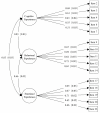The development and validation of a social media fatigue scale: From a cognitive-behavioral-emotional perspective
- PMID: 33481843
- PMCID: PMC7822276
- DOI: 10.1371/journal.pone.0245464
The development and validation of a social media fatigue scale: From a cognitive-behavioral-emotional perspective
Abstract
Social media fatigue (SMF), which refers to social media users' tendency to withdraw from social media because of feeling overwhelmed, is closely related to individuals' social life and well-being. Many studies focused on understanding SMF and exploring its enablers and influences. However, few pieces of research administered a standard measurement of SMF. This study aimed to develop and validate a measure of SMF, and a cross-sectional survey was conducted among 1599 participants in total. Semi-structured interviews of 30 participants were firstly conducted as a pilot study, and an initial version of the social media fatigue scale (SMFS) with 24 items was generated. Then, both exploratory factor analysis (N = 509) and confirmatory factor analysis (N = 552) as well as reliability and validity analysis (N = 508) were conducted and a 15-item SMFS was finally developed. The results demonstrated that: 1) SMF was a multi-dimension concept including a cognitive aspect, an emotional aspect and a behavioral aspect; 2) the three-dimensional structure of the SMFS (cognitive-behavioral-emotional structure) fitted the data well; 3) the McDonald's Omega coefficients for the SMFS was 0.83, suggesting that the SMFS was reliable; 4) criterion validity was satisfactory as indicated by both the significant correlations between self-rated scores of fatigue and total SMFS scores and the significant regression model of SMF on social media privacy, social media confidence, and negative feeling after comparison. Based on the Limited Capacity Model, the present study expanded SMF from a unidimensional model to a three-dimension model, and developed a 15-item SMFS. The study enriched the existing knowledge of SMF, and coined a reliable and valid tool for measuring it. Besides, concluding the typical characteristics of SMF, the study may provide some inspiration for both researchers and social media managers and operators in mitigating SMF.
Conflict of interest statement
The authors have declared that no competing interests exist.
References
-
- Team YS. Gartner survey highlights consumer fatigue with social media. 2011 Aug 16 [cited 1 July 2018]. In: YOURSTORY [Internet]. [about 4 screens]. https://yourstory.com/2011/08/gartner-survey-highlights-consumer-fatigue...
-
- Dhir A., Yossatorn Y., Kaur P., Chen S. Online social media fatigue and psychological wellbeing—A study of compulsive use, fear of missing out, fatigue, anxiety and depression. International Journal of Information Management. 2018; 40: 141–152.
-
- Bright LF., Kleiser SB., Grau SL. Too much Facebook? An exploratory examination of social media fatigue. Computers in Human Behavior. 2015; 44: 148–155.
-
- China Internet Network Information Center. The 42nd China Statistical Report on Internet Development. 2018 Aug 20 [cited 1 March 2019]. In: Cyberspace Administration of China [Internet]. [about 105 screens]. http://www.cac.gov.cn/2018-08/20/c_1123296882.htm.
-
- China Internet Network Information Center. The 43rd China Statistical Report on Internet Development. 2019 Feb 28 [cited 1 March 2019]. In: Cyberspace Administration of China [Internet]. [about 126 screens]. http://www.cac.gov.cn/2019-02/28/c_1124175677.htm.
Publication types
MeSH terms
LinkOut - more resources
Full Text Sources
Other Literature Sources




